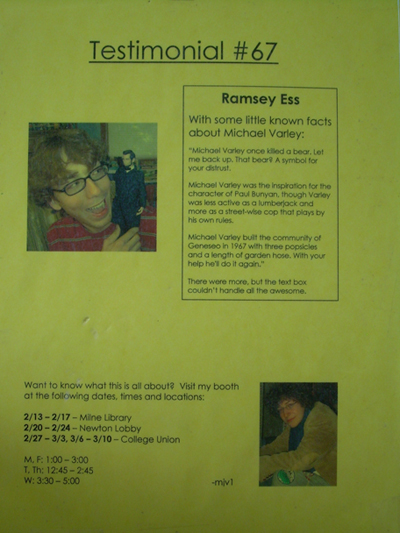
Community Art, Part I: The Scavenger Hunt
This was Part I of a semester long directed study I did my last semester at Geneseo. Going into the semester, I had no solid plans for the project. All I knew was that I wanted to work with the idea of viewer participation, but on a scale much larger than previous projects.
Very early on, there was a harebrained scheme involving a giant croquet set, but (thankfully) the school bureaucracy wouldn’t give me the support necessary to pull it off. I turned my thoughts to the previous projects for inspiration. What was it about them that appealed to me? Interacting with people was part of it, but that didn’t tell the whole story. It was interaction with a common purpose. I’d supply a provocative object and then call upon people to consider it, critique it, and ultimately complete it. It was creating that rallying point that I enjoyed so much – creating an object that creates community.
It was this fascination with the idea of “community” that became the focus of my senior thesis. The plan came together quickly. I would call on the two communities that had become dearest to me over the past 3-1/2 years – my immediate Geneseo community and the Geneseo community at large – to create a sculpture that would both foster and examine the idea of community.
First was the immediate Geneseo community. I sent out an email to every person at Geneseo I knew by name. Anyone I had become familiar with over the previous seven semesters received one, regardless of whether or not we still talked to each other. The email address bar ran the full spectrum, from girlfriend to orientation roommate. The email asked them to provide a headshot and a testimonial on my behalf, stating things like why I’m a trustworthy person, why they think Part II of the project will be a winner, and so on.
I gave myself three weeks to collect the testimonials from everyone. In between hunting down people for pictures and waiting for testimonials to come in through email, I contacted another crucial part of my Geneseo community: the businesses I had patroned during my time in the town. I went door-to-door, asking store managers for gift certificates and leaving letters behind for managers that weren’t around.
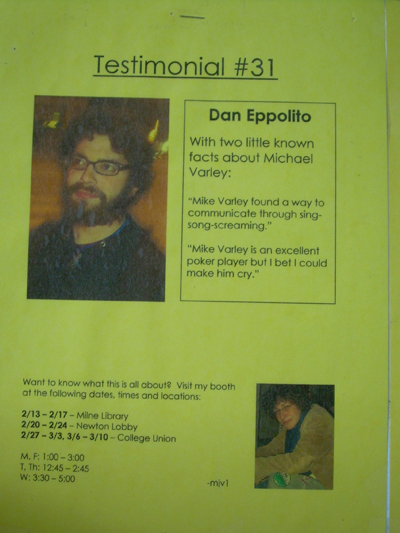
All told, I got 94 testimonials after sending out the email to 150 people. There were some interesting bumps in the process along the way. One person gave me a testimonial and then withdrew it after I refused to tell said person the details behind Part II of the project. I had stated in the email that Part II was a secret and the testimonials were in large measure a way to counter the mistrust members of the greater Geneseo community might feel about the secrecy. On withdrawing the testimonial, the person told me that it was nothing personal; they just couldn’t blindly trust me with representing them.
What was interesting about this was that person wasn’t some orientation roommate or intramural teammate. Instead, said person was someone I took for granted as an automatic testimonial. I was told not to take it personal and behaved accordingly, but inside I couldn’t help but take offence. It very much was personal, not because the person didn’t want to participate in the project, but because, in a roundabout way, the person was saying I wasn’t trustworthy. I wasn’t capable or responsible enough to march with their banner.
“Do you trust me” is not a question asked casually, and yet I sent it out to 150 people via email. I knew there were many people I sent the email to that wouldn’t trust me due to friendship inactivity, but I took for granted the trust of some people that I never received a response from. Their lack of a reply didn’t bother me so much, as I could talk myself into believing they had been too lazy to submit a response. Even apathy was an acceptable, albeit unfortunate, reaction in my mind. But to have someone submit a testimonial and then take it back made me realize that not only was it distressing to find out people didn’t trust me, it was more distressing to learn that – gasp – people might feel different about me than I feel about them. Here I am, ready to let this person watch my house for the weekend and they’re still debating whether or not to leave their backpack at the table while they go to the bathroom. To invest energy in a relationship and then not get the proper return is a disconcerting feeling. If there’s unrequited love for romantic relationships, perhaps the friendship equivalent is unrequited trust.
The testimonial withdrawer was not the only person concerned with their identity being compromised. There was also a short exchange of emails between myself and a friend I’d known all throughout college. The person sent me a somewhat terse reply to my initial email, and in response I told the person in a conversational manner (a stupid thing to do in email communication) not to “be difficult.” The reply I received was
this.
As
you might imagine, I was rather taken aback by the content. I
crafted this reply, careful to cover everything the email
asks of me. In the long run the email proved helpful to me, if
for no other reason than it forced me to think more about my definition
of community. Also, I did get a testimonial from this person.
[As a sidenote, I have suspended my moratorium on voting for at least
the 2008 elections.]
These
incidences aside, collecting testimonials turned out to be a very positive
experience. Responses ranged the spectrum, from silly to non-sensical
, risqué to heartfelt. In many ways, collecting the testimonials
was like creating an unorthodox yearbook for myself before I left college.
Soliciting
businesses for gift certificates went surprisingly well. I got
fifteen certificates total for my efforts. It was my first experience
with asking businesses for handouts and I was pretty bad at first.
I kept trying to explain the project to the person in charge when really
they just wanted to know the bottom line. I learned to skip the
details as time progressed, but I still preferred it when the boss wasn’t
there and I could just hand over letter spelling out my intent.
As it turned out, I actually did better when I didn’t have to talk
to the person in charge, receiving my largest donations from owners
that read the letter only. I also got some compliments on the
quality of the letter when I went to go pick up my booty. Maybe
I’m pursuing the right profession after all.
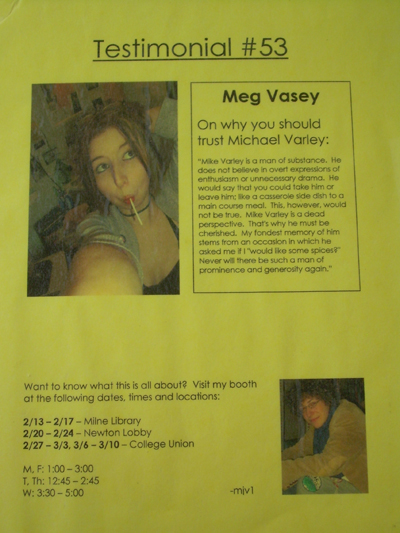
An
aside for all you starving artists willing to be a little disreputable:
chain stores – in my case, Subway and Pizza Hut – don’t seem to
give a damn what you’re raising money for. At Subway they had
coupon books filled with what must have been 200 free 6” sub slips,
and the Pizza Hut manager literally stopped me from talking and started
writing out a gift certificate the moment I said “fundraiser”.
I imagine all you’d have to do is cook yourself up a charity letter
and bluff your way to victory. They probably won’t even ask
for the letter, but it looks good to have written confirmation of whatever
you just said. So long as you have the intestinal fortitude, there’s
free eats to be had.
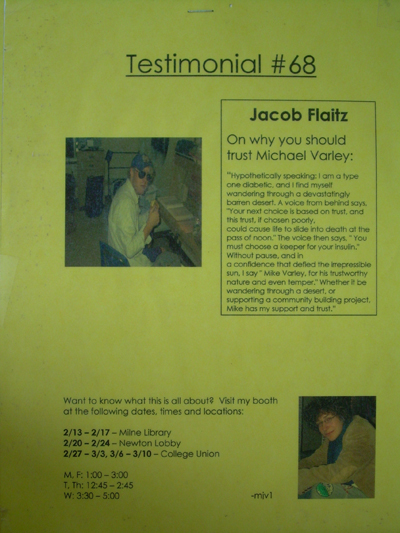
With
testimonials and gift certificates in hand, it was time to start the
interactive portion of the project. First, I tacked up testimonials
on corkboards all around the Geneseo. Then, for the next month,
I held a continuous scavenger hunt. Potential scavengers would
come to the booth I had set up and purchase
a scavenger hunt list for a dollar. There were fifteen
specific testimonials to be found each week. Upon finding all
the posters for the week, you’d come back to my booth and I’d give
you a gift certificate from the Geneseo business prize pool.
It was made clear that all money raised went to Part II of my project,
a top-secret sculpture that involved every student and faculty member
on campus.
The
project went pretty well, raising over a hundred dollars, but it never
met the lofty expectations my imagination had for it. As for why
it never met my expectations, it’s hard to know where my unrealistic
expectations stopped and student apathy began. Not even the siren
song of free Jolly Ranchers could get most people to stop and ask what
I was doing. A few people complained how they’d do it if only
they weren’t so bogged down with work, but there was a whole month
to give it a shot and a week’s hunt only took about an hour and a
half.
Another
common complaint was how if only money weren’t involved, I’d be
all about it. This was a complaint I spent more time thinking
about. The project wasn’t about money in the sense that I didn’t
need charity to pay for the sculpture materials. I liked the idea
that I could spend only what the community gave me on materials, but
I didn’t like it enough to sacrifice the success of part of my project.
So then why not just give out the lists for free and let everyone have
a good time? It would go far to achieving my two goals for the
hunt: raising awareness for Part II of the project and smudging the
lines between my immediate and larger Geneseo communities. So
why didn’t I do it?
I
didn’t offer the lists for free because to do so would remove a crucial
element from the piece: the idea of dollar bills representing an investment
on the part of the community. In a sense, the dollar bills become
certificates of trust. Why is this sign of trust important?
Because it completes the cycle of the project. I asked friends,
professors and co-workers to produce testimonials that would inspire
complete strangers to trust in me. I asked businesses to provide
goods in order to further prove me capable and trustworthy. To
not ask for some token of trust from the participants after taking all
that effort to inspire trust is to cheapen the project, let down my
benefactors and call my own integrity into question. So while
it would have been great to have everyone on campus running around with
a scavenger hunt list, becoming familiar with me through the testimonials
and warping the line between my immediate Geneseo community and the
Geneseo community at large, to offer the lists for free would be to
destroy the context that made my efforts art in the first place and
turn it all into a glorified popularity contest – minus the election.
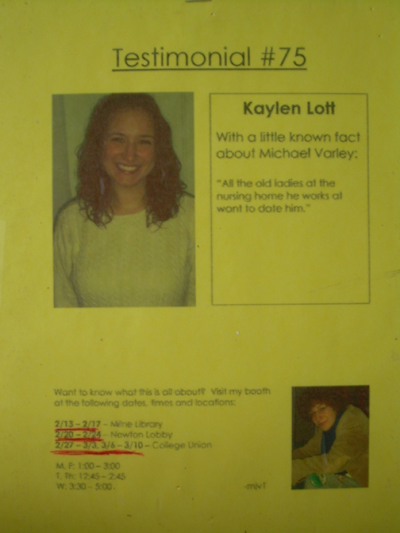
A
lovely afterward to this piece: I was informed by a friend of mine that
still went to Geneseo that the following year, a sorority ripped off
my poster idea and format and used it to promote their pledge week.
Oh, what a referential world we live in.
Click here for a random testimonial
| 